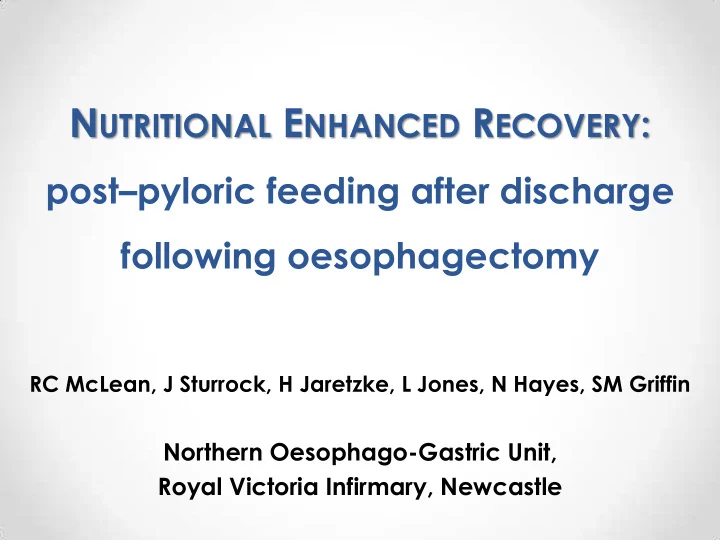

N UTRITIONAL E NHANCED R ECOVERY : post – pyloric feeding after discharge following oesophagectomy RC McLean, J Sturrock, H Jaretzke, L Jones, N Hayes, SM Griffin Northern Oesophago-Gastric Unit, Royal Victoria Infirmary, Newcastle
Background Oesophagectomy is associated with: • o Pre- and postoperative nutritional difficulties o Protein-energy malnutrition (defined as >10% weight loss) Postoperative nutritional enhanced recovery: Post-pyloric feeding (PPF) inserted at surgery: Surgical Jejunostomy Early introduction of enteral feeding: all patients Discontinued prior to discharge Overnight feeding following discharge (Low risk of FTT) (High risk for FTT*) *Considerations to continue PPF after discharge: unable to maintain >50% of required caloric intake, preoperative weight loss >10%, oral route compromised, low preoperative body weight, clinically significant postoperative weight loss prior to discharge
Methods • This retrospective audit aimed to: 1. Describe weight changes following oesophagectomy 2. Investigate the influence of PPF following discharge on postoperative weight changes and readmissions • Reviewed notes 210 patients who underwent oesophagectomy 1/1/12 – 30/4/14
Results 37 patients (17.6%) discharged home with post-pyloric feeding Post-pyloric Feeding No feeding Median (N=37) (N=173) Duration after discharge 78 days Age 67 years 65 years Postoperative LoS 15 days 14 days Gender (male) 62.1% 73.8% Preoperative BMI (kg/m 2 ) 24.6 26.0 (p=0.016*)
Change in weight: median weight loss vs. preoperative -16.0% Discharge: PPF (%) -14.0% Discharge: No PPF (%) Weight Loss (%) -12.0% -10.0% -8.0% -6.0% -4.0% -2.0% 0.0% 0-3 0-6 0-12 0-2 weeks 0-6 weeks months months months post D/C post D/C post-Op post-Op post-Op Discharge: PPF (%) -3.9% -3.2% -6.8% -8.0% -11.2% Discharge: No PPF (%) -8.2% -9.8% -14.1% -12.8% -12.6% p- value ‡ <0.001** <0.001** <0.001** <0.001** 0.364 ‡ KW & post -hoc MW analyses with Holm’s correction
Change in weight: weight loss >10% vs. preoperative 60.0% Proportion of Patients with Discharge:PPF (N=37) Discharge: No PPF (N=160) weight loss >10% (%) 50.0% 40.0% 30.0% 20.0% 10.0% 0.0% 0-2 0-6 0-3 0-6 0-12 weeks weeks months months months post D/C post D/C post-Op post-Op post-Op Discharge:PPF (N=37) 10.8% 24.3% 29.7% 43.2% 37.8% Discharge: No PPF (N=160) 20.0% 33.8% 33.8% 53.8% 42.5%
Change in weight: median weight loss Change in Weight (kg) 0 -2 -4 -6 -8 -10 -12 0-2 0-6 0-3 0-6 0-12 weeks weeks months months months Discharge: PPF (Kg) -2.9 -2.4 -5 -5.95 -8.3 Discharge: PPF (%) -3.9% -3.2% -6.8% -8.0% -11.2% Discharge: No PPF (Kg) -6.5 -7.8 -11.2 -10.2 -10 Discharge: No PPF (%) -8.2% -9.8% -14.1% -12.8% -12.6% p-value <0.001** <0.001** <0.001** <0.001** 0.364
Readmissions: Failure to Thrive Post-pyloric No Post-pyloric p-Value feeding Feeding Readmissions 18 64 0.359 7 42 Failure to Thrive 0.021* (38.9%) (65.6%)
Conclusions • Oesophagectomy is associated with substantial weight loss over a short period of time • Post-pyloric feeding after discharge associated with: o Significantly less weight loss o Significantly fewer readmissions with failure to thrive • This audit supports the implementation of PPF at discharge in patients at risk of FTT
Recommend
More recommend